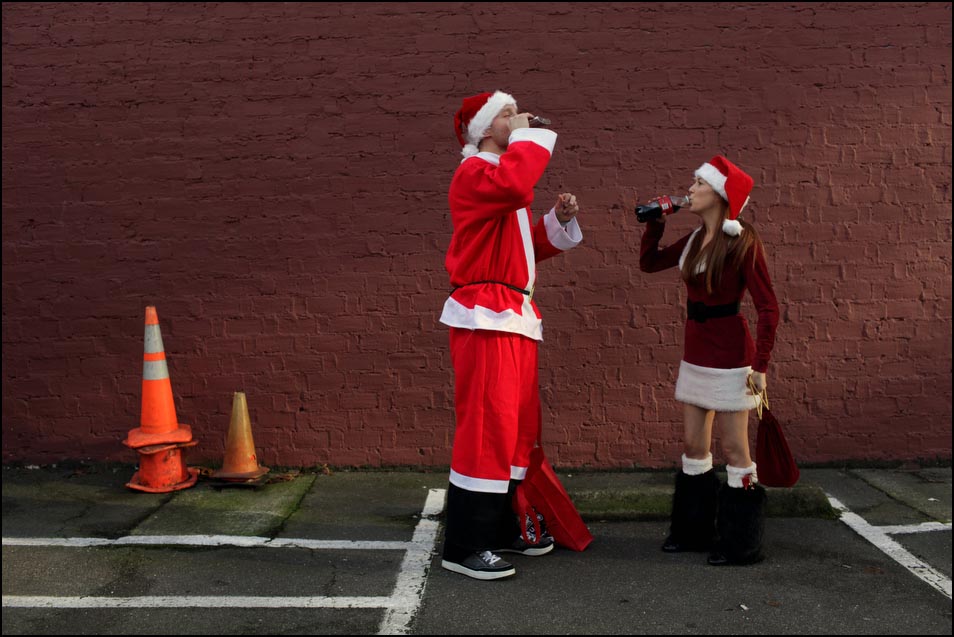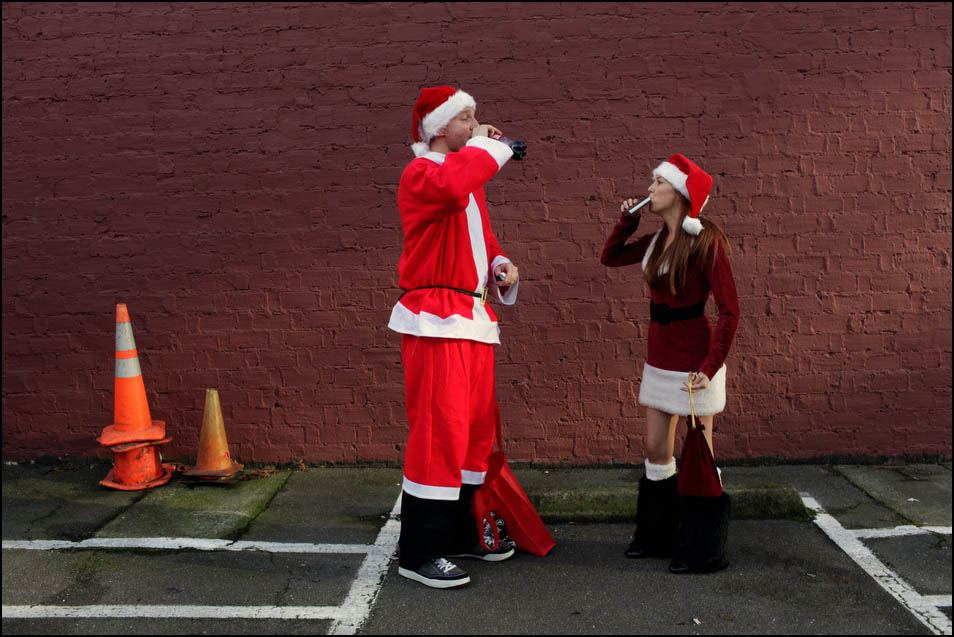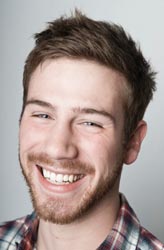Spotlight on Jordan Stead
Nov 12, 2012

TID:
What a great image! Please tell us a little of the backstory of the image.
JORDAN:
Thank you very much for the opportunity to be featured on TID. As a longtime viewer, this means a lot to me.
While on a freelance assignment for The Seattle Post-Intelligencer in December of 2011, I was at the tail end of shooting an event aptly named "Seattle Santarchy." I greatly enjoy covering quirky events. I would much rather photograph a dive bar drag show than a big sporting event. Santarchy was no such exception. A mob of red-clad Santas had taken to the streets of downtown Seattle to smoke cigars, drink from flasks and cause general holiday mayhem. My edit for the day was getting there, but what I was missing was a strong moment.
TID:
How did you prepare for this shoot, or what did you to put yourself in place to document this moment?
JORDAN:
After running ahead of the traveling Santa pack to photograph the party from the front, I retreated onto the sidewalks to flank the crowd and keep my eyes peeled for a quiet moment. After the group left another bar, I noticed two Santas - one man, one woman - standing in a vacant parking lot across the street. I quickly made my way to the opposite sidewalk and raised my camera.

TID:
What challenges did you encounter while working to make this image?
JORDAN:
It's actually less about the challenge of making this particular image and more about the mental control it takes to keep wild events like this from overwhelming your brain and eyeballs. I remember being less experienced and finding myself either a) nearly frozen in the midst of a sea of amazing potential pictures or b) shooting with reckless abandon by putting less thought into composition and scene awareness than remaining focused on making strong images. After all, photography is a set of skills and rules that must first be "mastered" and then promptly broken, as to avoid the potential pitfall of creating images that follow a textbook example of what a "good photograph" should be.
TID:
How do you mentally focus on not get overwhelmed?
JORDAN:
You've got numbers, biases, changing light, moments that last a millisecond and a deadline bearing down on you. The process is all about balance, closely followed by control of over your internal doubts and fears at the time of the decisive moment. Having the technical ability is only the beginning. It is when the numbers junk falls to the subconscious that a photographer can truly begin to make pictures freely, focusing on the elements that contribute to a striking image.

TID:
Can you expand on this?
JORDAN:
Sometimes, you feel like a glaring beacon in the center of a scene simply because you have a camera in front of your face. The trick for me is to reassure myself by saying, "No one cares. No one gives a shit that you're here." Because it's true. That age-old feeling of heightened personal awareness has got to be one of the greatest culprits of great photographs never made. Once that thought process is realized and practiced, photographing people (in sensitive situations or otherwise) becomes much easier. Of course there are exceptions, but that disregard of your personal anxiety and "presence" can often ease your mind amidst a hectic scene.
The bottom line is that if the picture never gets made - for whatever reason - there is nothing to show for it, and no amount of describing can recreate that moment lost. It's akin to describing the intricacies of a delicious meal or explaining the way a color appears to your eye. The best way of combatting that feeling? Revel in it. Embrace the awkwardness, make a fool of yourself and laugh under your breath at how nerdy you probably look (and most certainly feel).
TID:
Now, onto the moment. Can you talk about the moments leading up to the picture and also the actual moment?
JORDAN:
After making my way into the parking lot with my camera up to my eye (a bad habit that I've come close to perfecting, but will most likely kill me one day), I began to shoot as the couple worked their way through a flask of alcohol. At the time, I remember the flatness of the image, and without the strength of the (approaching) moment, I began to step to my right to add more depth to the picture. My thought here would most likely have been to use the line of the wall meeting the parking lot to act as a leading compositional element, rather than a background.

As the young man lunged at his girlfriend and bent her over backwards for a kiss, I stepped back to my left and let the burgundy of the painted brick wall clean up the background of the picture. I shot the entire series - minus the first of the five - at 1/500 at f/4 at ISO 400 with a 35mm lens. Five pictures just under 20 seconds. My placement paid off, however, as his girlfriend pushed against him from her end of the kiss, bringing their bodies back into a similar shape present in the first of the five images. I shot two frames of them this way, and as they broke apart, I made my presence known by announcing who I was, who I was shooting for and that I would love their names for a caption. They agreed, and we chatted for a few minutes before parting ways.
TID:
What surprised you about the moment?
JORDAN:
While the surrounding images in the series are very similar (especially the final two), the selected picture jumped out at me because of its subtle details. Often, it is the little things that really make a picture for me. In this photo, it is her unexpected enthusiasm, his resulting surprise, a slight loss of balance and the framing lines of the pavement coupled with the shafts of light on the wall behind them. Everything just fell into place. That being said, this is one of those images that I'll never forget making, despite the fact that it's not a particularly epic picture. When light meets moment meets composition, you've got it. That feeling - when those elements fall in line and that shutter comes down - cannot be matched.

TID:
What have you learned about yourself in the process of making images like this?
JORDAN:
This "kind" of image, at least stylistically, is one of my favorites to make. It's a fun moment with pretty light, good color and a little bit of weirdness. I think it's important to look for light, often before moments. I can only be so prepared for moments, whereas if I notice a patch of tasty light, I might stick nearby and work it for as long as it lasts. Occasionally, I'll get lucky as I did here, when moments happen where you want them.
TID:
In conclusion, what advice do you have for photographers?
JORDAN:
Stay on your toes, both figuratively and literally. Moments are called moments for a reason - they're fast. That slight second of hesitation can cost any photographer a great picture, regardless of years of experience, incredible gear or perfect body placement. Get involved and stay involved with as many things as possible. Surround yourself with positive, like-minded people. Work and work and work - and then work some more. Your style and eye will come to you in time; it may not be today, or next week, or next year - but it will come. Lastly, enjoy every moment shooting!

:::BIO:::

Jordan Stead is a photojournalist and 2011 graduate from Western Washington University with a major in visual journalism and a minor in environmental studies. He has interned and been affiliated with such companies as The Seattle Times, ZUMA Press, High Country News, The (Provo) Daily Herald, The Bellingham Herald and The Skagit Valley Herald. His work - both in stills and video - has received national attention through awards with the National Press Photographers Association, the Society of Professional Journalists, Scripps Howard and the American Photo Magazine.
Stead recently attended the 25th anniversary of the Eddie Adams Workshop after being accepted into the professional's bracket in mid-2012. In late 2011, Stead began to plan in advance for the end of the internship era and co-founded a three-man visual productions company called The Emerald Collective alongside fellow photographer Mark Malijan and digital producer Kyle Seago. The three continue to work together on commercial and non-profit based projects, operating as full-time freelance business owners in Seattle, Washington. Aside from organizing the world into one rectangle at a time, Stead enjoys cold showers, hot vacations and temperate attitudes.
You can view his work here:
Personal site / portfolios: www.jordanbstead.com
The Emerald Collective: www.theemeraldcollective.com
